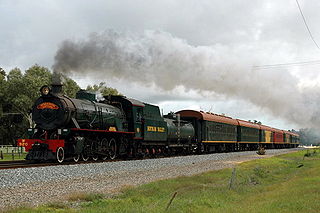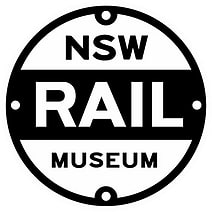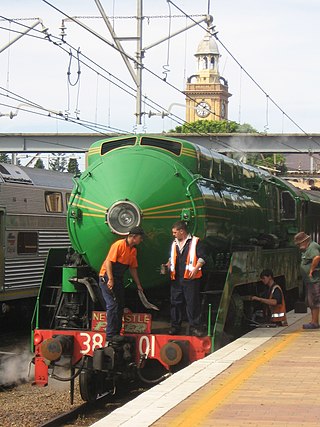
DSB, an abbreviation of Danske Statsbaner, is the largest Danish train operating company, and the largest in Scandinavia. While DSB is responsible for passenger train operation on most of the Danish railways, goods transport and railway maintenance are outside its scope. DSB runs a commuter rail system, called the S-train, in the area around the Danish capital, Copenhagen, that connects the different areas and suburbs in the greater metropolitan area. Between 2010 and 2017, DSB operated trains in Sweden.

The British Rail Class 55, also known as a Deltic, or English Electric Type 5, is a class of diesel locomotive built in 1961 and 1962 by English Electric for British Railways. Twenty-two locomotives were built, designed for the high-speed express passenger services on the East Coast Main Line (ECML) between Edinburgh and London King's Cross. They gained the name "Deltic" from the prototype locomotive, DP1 Deltic, which in turn was named after its Napier Deltic power units. At the time of their introduction into service in 1961, the Class 55s were the most powerful single-unit diesel locomotives in the world, with a power output of 3,300 hp (2,500 kW). They had an official maximum speed of 100 miles per hour (160 km/h), and introduced the first regular 100 mph diesel passenger service to Britain, they were however capable of higher speeds than this, and often exceeded their official maximum in service, especially in their later years, with speeds of up to 117 miles per hour (188 km/h), being recorded on level gradients, and up to 125 miles per hour (201 km/h) whilst descending Stoke Bank.

The British Rail Class 47 or Brush Type 4 is a class of diesel-electric locomotive that was developed in the 1960s by Brush Traction. A total of 512 Class 47s were built at Brush's Falcon Works in Loughborough and at British Railways' Crewe Works between 1962 and 1968, which made them the most numerous class of British mainline diesel locomotive.

In rail transport, head-end power (HEP), also known as electric train supply (ETS), is the electrical power distribution system on a passenger train. The power source, usually a locomotive at the front or 'head' of a train, provides the electricity used for heating, lighting, electrical and other 'hotel' needs. The maritime equivalent is hotel electric power. A successful attempt by the London, Brighton and South Coast Railway in October 1881 to light the passenger cars on the London to Brighton route heralded the beginning of using electricity to light trains in the world.

The Hotham Valley Tourist Railway is a tourist and heritage railway in the Peel region of Western Australia.
NOHAB was a manufacturing company based in the city of Trollhättan, Sweden.

The NSW Rail Museum is the main railway museum in New South Wales, Australia. A division of Transport Heritage NSW, it was previously known as the New South Wales Rail Transport Museum (NSWRTM), Rail Heritage Centre and Trainworks.
Push–pull is a configuration for locomotive-hauled trains, allowing them to be driven from either end of the train, whether having a locomotive at each end or not.

The DSB Class MF is a Danish-built high-comfort medium/long distance diesel multiple-unit train. The sets were built by ABB Scandia in Randers. This train model has been operating in Denmark, Sweden and Israel since 1990. The name IC3 indicates simply that it is a three-carriage InterCity trainset.

NSB Di 3 is a class of 35 diesel-electric locomotives built by NOHAB for the Norwegian State Railways (NSB). The class was built between 1954 and 1969, and delivered in two series, Di 3a and Di 3b. They are based on the Electro-Motive Division F7 and are equipped with EMD 567 engines. They have a distinct bulldog nose and were numbered 602–633 (a-series) and 641–643 (b-series). The locomotives had a prime mover that gives a power output of 1,305 kilowatts (1,750 hp). The a-series has a Co′Co′ wheel arrangement, while the b-series has (A1A)(A1A). The b-series has higher top speed, but lower tractive effort.

The Dorrigo Steam Railway and Museum in Dorrigo, New South Wales, Australia is a large, privately owned collection of railway vehicles and equipment from the railways of New South Wales, covering both Government and private railways. The collection dates from 1878 until 1985.
Railmotor is a term used in the United Kingdom and elsewhere for a railway lightweight railcar, usually consisting of a railway carriage with a steam traction unit, or a diesel or petrol engine, integrated into it.
The railways of New South Wales, Australia, use a large variety of passenger and freight rolling stock. The first railway in Sydney was opened in 1855 between Sydney and Granville, now a suburb of Sydney but then a major agricultural centre. The railway formed the basis of the New South Wales Government Railways. Passenger and freight services were operated from the beginning. By 1880, there was a half hourly service to Homebush.

The class MY is a class of diesel-electric locomotives built in the years 1954–65 by NOHAB. A total of 59 units, numbered 1101–1159, were delivered to the Danish State Railways. Powered by GM-EMD engines, the locomotives represented a significant change in rolling stock policy — motive power had largely been sourced from within Denmark for several decades.

DSB class MZ was a series of 61 diesel-electric locomotives operated by Danske Statsbaner. They were built by NOHAB between 1967 and 1978 under licence from General Motors EMD with subcontractors Thrige-Titan and Frichs. There were four series of the locomotive built, designated I – IV.

The Newcastle Flyer was an Australian passenger express train that operated from November 1929 until April 1988 connecting New South Wales' two largest cities, Sydney and Newcastle.
The Danish State Railways (DSB) class D steam locomotive was a 2-6-0 freight steam locomotive developed in co-oporation between the DSB central engineering department and the German locomotive manufacturer Henschel. Class D with 100 units became the backbone of the DSB freight locomotives from the start of its delivery in 1902 until the start of the 1950s when the significance of the railway traffic started to decline. Together with the previous deliveries of the heavier 2-8-0 class H freight locomotive and then in 1952 purchased 10 Belgian-built German class 50ÜK locomotives, pushed the class D to the sidelines. When the light GM diesel locomotive class MX was delivered in the start of the 1960s, it was the swansong for class D. Only two class D engines were serviceable when DSB abandoned steam in 1970; D 825 and D 826.
London's Metropolitan Railway (MR) amalgamated with other underground railways, tramway companies and bus operators on 1 July 1933, to form the London Passenger Transport Board (LPTB); the MR became the Board's Metropolitan line.

The South Australian Railways F class is a class of 4-6-2T steam locomotives operated by the South Australian Railways.

Frichs is a Danish company based in Horsens, founded in 1854 in Aarhus. Frichs today produce ship engines but started out in the 19th century producing a long range of farm and industry equipment, ships, church bells, cranes and later through the 20th century locomotives and train carriages. In the early to mid 20th century it was a major company and employer in Aarhus at its height employing some 1000 people. The company was the sole Danish supplier of locomotives for the Danish State Railways from 1919 to the mid 1950s and sold locomotives across Europe and to Siam and New Zealand. In 1980 the company was sold to Kosan and then restructured and rebased to Horsens.
















